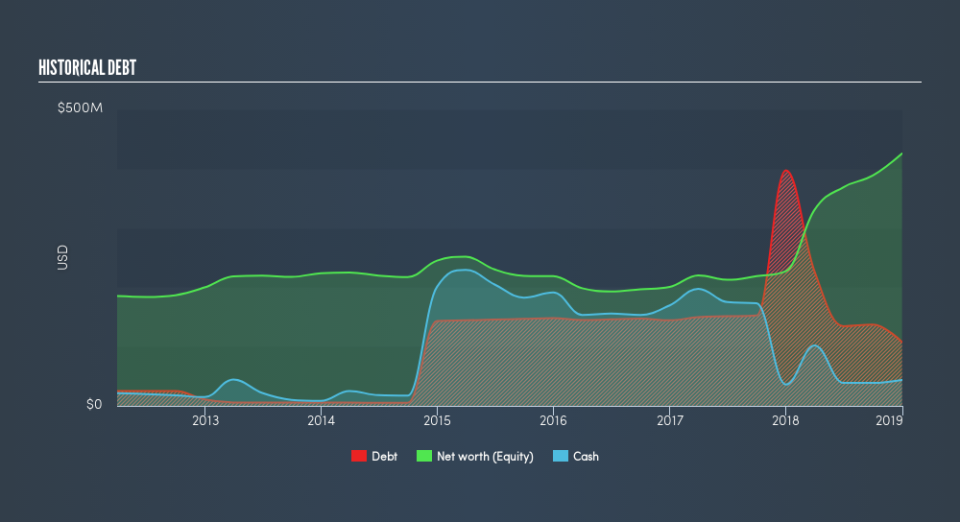Why Quidel Corporation (NASDAQ:QDEL) Is A Financially Healthy Company

Want to participate in a research study? Help shape the future of investing tools and earn a $60 gift card!
Small-cap and large-cap companies receive a lot of attention from investors, but mid-cap stocks like Quidel Corporation (NASDAQ:QDEL), with a market cap of US$2.6b, are often out of the spotlight. However, generally ignored mid-caps have historically delivered better risk adjusted returns than both of those groups. Let’s take a look at QDEL’s debt concentration and assess their financial liquidity to get an idea of their ability to fund strategic acquisitions and grow through cyclical pressures. Note that this commentary is very high-level and solely focused on financial health, so I suggest you dig deeper yourself into QDEL here.
See our latest analysis for Quidel
QDEL’s Debt (And Cash Flows)
Over the past year, QDEL has reduced its debt from US$397m to US$108m , which includes long-term debt. With this debt payback, the current cash and short-term investment levels stands at US$44m to keep the business going. Additionally, QDEL has produced US$136m in operating cash flow during the same period of time, resulting in an operating cash to total debt ratio of 127%, indicating that QDEL’s debt is appropriately covered by operating cash.
Can QDEL pay its short-term liabilities?
Looking at QDEL’s US$160m in current liabilities, it seems that the business has maintained a safe level of current assets to meet its obligations, with the current ratio last standing at 1.21x. The current ratio is the number you get when you divide current assets by current liabilities. For Medical Equipment companies, this ratio is within a sensible range since there is a bit of a cash buffer without leaving too much capital in a low-return environment.
Is QDEL’s debt level acceptable?
With a debt-to-equity ratio of 25%, QDEL's debt level may be seen as prudent. This range is considered safe as QDEL is not taking on too much debt obligation, which may be constraining for future growth. We can check to see whether QDEL is able to meet its debt obligations by looking at the net interest coverage ratio. A company generating earnings before interest and tax (EBIT) at least three times its net interest payments is considered financially sound. In QDEL's, case, the ratio of 4.73x suggests that interest is appropriately covered, which means that lenders may be less hesitant to lend out more funding as QDEL’s high interest coverage is seen as responsible and safe practice.
Next Steps:
QDEL has demonstrated its ability to generate sufficient levels of cash flow, while its debt hovers at an appropriate level. In addition to this, the company will be able to pay all of its upcoming liabilities from its current short-term assets. This is only a rough assessment of financial health, and I'm sure QDEL has company-specific issues impacting its capital structure decisions. You should continue to research Quidel to get a more holistic view of the stock by looking at:
Future Outlook: What are well-informed industry analysts predicting for QDEL’s future growth? Take a look at our free research report of analyst consensus for QDEL’s outlook.
Valuation: What is QDEL worth today? Is the stock undervalued, even when its growth outlook is factored into its intrinsic value? The intrinsic value infographic in our free research report helps visualize whether QDEL is currently mispriced by the market.
Other High-Performing Stocks: Are there other stocks that provide better prospects with proven track records? Explore our free list of these great stocks here.
We aim to bring you long-term focused research analysis driven by fundamental data. Note that our analysis may not factor in the latest price-sensitive company announcements or qualitative material.
If you spot an error that warrants correction, please contact the editor at editorial-team@simplywallst.com. This article by Simply Wall St is general in nature. It does not constitute a recommendation to buy or sell any stock, and does not take account of your objectives, or your financial situation. Simply Wall St has no position in the stocks mentioned. Thank you for reading.

